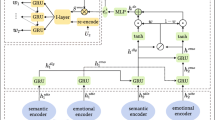Abstract
Emotion is an important factor to the success of conversational agents or chatbot. Existing chatbots have been shown to be good for generating natural responses. However, they still lack mechanisms to integrate emotional information. In this paper, we propose an approach that can produce emotion-specific responses by encoding emotional information into sequence-to-sequence model. The experimental results show that the proposed model generates responses appropriate to content and emotion. Specifically, this model improves up to 10% in emotional precision and 50% BLEU score compared to the baseline.
Access this chapter
Tax calculation will be finalised at checkout
Purchases are for personal use only
Similar content being viewed by others
References
Cho, K., van Merrienboer, B., Gülçehre, Ç., Bougares, F., Schwenk, H., Bengio, Y.: Learning phrase representations using RNN encoder-decoder for statistical machine translation. CoRR abs/1406.1078 (2014). http://arxiv.org/abs/1406.1078
Colombo, P., Witon, W., Modi, A., Kennedy, J., Kapadia, M.: Affect-driven dialog generation. CoRR abs/1904.02793 (2019). http://arxiv.org/abs/1904.02793
Devlin, J., Chang, M., Lee, K., Toutanova, K.: BERT: pre-training of deep bidirectional transformers for language understanding. CoRR abs/1810.04805. (2018). http://arxiv.org/abs/1810.04805
Ekman, P.: An argument for basic emotions (1992)
Guo, P.: Snowbot: an empirical study of building chatbot using seq 2 seq model with different machine learning framework (2017)
Hu, Z., Yang, Z., Liang, X., Salakhutdinov, R., Xing, E.P.: Controllable text generation. CoRR abs/1703.00955 (2017). http://arxiv.org/abs/1703.00955
Huang, C., Zaïane, O., Trabelsi, A., Dziri, N.: Automatic dialogue generation with expressed emotions. In: Proceedings of the 2018 Conference of the North American Chapter of the Association for Computational Linguistics: Human Language Technologies, Volume 2 (Short Papers), pp. 49–54. Association for Computational Linguistics, New Orleans, Louisiana (Jun 2018). 10.18653/v1/N18-2008, https://www.aclweb.org/anthology/N18-2008
Li, J., Galley, M., Brockett, C., Gao, J., Dolan, B.: A diversity-promoting objective function for neural conversation models. CoRR abs/1510.03055 (2015). http://arxiv.org/abs/1510.03055
Li, Y., Su, H., Shen, X., Li, W., Cao, Z., Niu, S.: DailyDialog: a manually labelled multi-turn dialogue dataset. In: Proceedings of the Eighth International Joint Conference on Natural Language Processing (Volume 1: Long Papers), pp. 986–995. Asian Federation of Natural Language Processing, Taipei, Taiwan (Nov 2017). https://www.aclweb.org/anthology/I17-1099
Lubis, N., Sakti, S., Yoshino, K., Nakamura, S.: Eliciting positive emotion through affect-sensitive dialogue response generation: a neural network approach. In: AAAI (2018)
Luong, M., Pham, H., Manning, C.D.: Effective approaches to attention-based neural machine translation. CoRR abs/1508.04025 (2015). http://arxiv.org/abs/1508.04025
Miller, A.H., Feng, W., Fisch, A., Lu, J., Batra, D., Bordes, A., Parikh, D., Weston, J.: Parlai: A dialog research software platform. CoRR abs/1705.06476 (2017). http://arxiv.org/abs/1705.06476
Mohammad, S.: Obtaining reliable human ratings of valence, arousal, and dominance for 20,000 English words. In: Proceedings of the 56th Annual Meeting of the Association for Computational Linguistics (Volume 1: Long Papers), pp. 174–184. Association for Computational Linguistics, Melbourne, Australia (Jul 2018). 10.18653/v1/P18-1017. https://www.aclweb.org/anthology/P18-1017
Mou, L., Song, Y., Yan, R., Li, G., Zhang, L., Jin, Z.: Sequence to backward and forward sequences: a content-introducing approach to generative short-text conversation. CoRR abs/1607.00970 (2016). http://arxiv.org/abs/1607.00970
Pamungkas, E.W.: Emotionally-aware chatbots: a survey. ArXiv abs/1906.09774 (2019)
Papineni, K., Roukos, S., Ward, T., Zhu, W.J.: Bleu: a method for automatic evaluation of machine translation (10 2002). https://doi.org/10.3115/1073083.1073135
Serban, I.V., Sordoni, A., Bengio, Y., Courville, A.C., Pineau, J.: Hierarchical neural network generative models for movie dialogues. CoRR abs/1507.04808 (2015). http://arxiv.org/abs/1507.04808
Sutskever, I., Vinyals, O., Le, Q.V.: Sequence to sequence learning with neural networks. CoRR abs/1409.3215 (2014). http://arxiv.org/abs/1409.3215
Xing, C., Wu, W., Wu, Y., Liu, J., Huang, Y., Zhou, M., Ma, W.: Topic augmented neural response generation with a joint attention mechanism. CoRR abs/1606.08340 (2016). http://arxiv.org/abs/1606.08340
Zhou, H., Huang, M., Zhang, T., Zhu, X., Liu, B.: Emotional chatting machine: Emotional conversation generation with internal and external memory. CoRR abs/1704.01074 (2018). http://arxiv.org/abs/1704.01074
Acknowledgements
This research is funded by Vietnam National Foundation for Science and Technology Development (NAFOSTED) under grant 102.05-2020.26.
Author information
Authors and Affiliations
Corresponding author
Editor information
Editors and Affiliations
Rights and permissions
Copyright information
© 2021 The Author(s), under exclusive license to Springer Nature Singapore Pte Ltd.
About this paper
Cite this paper
Tran-Luong, QD., Le, AC., Pham, DH. (2021). Emotionally-Aware Sequence-to-Sequence Models for Conversational Systems. In: Pan, JS., Li, J., Ryu, K.H., Meng, Z., Klasnja-Milicevic, A. (eds) Advances in Intelligent Information Hiding and Multimedia Signal Processing. Smart Innovation, Systems and Technologies, vol 212. Springer, Singapore. https://doi.org/10.1007/978-981-33-6757-9_39
Download citation
DOI: https://doi.org/10.1007/978-981-33-6757-9_39
Published:
Publisher Name: Springer, Singapore
Print ISBN: 978-981-33-6756-2
Online ISBN: 978-981-33-6757-9
eBook Packages: Intelligent Technologies and RoboticsIntelligent Technologies and Robotics (R0)




